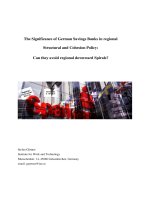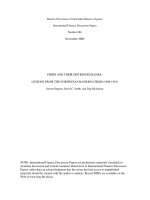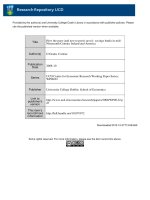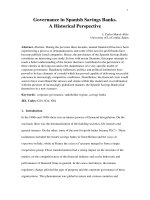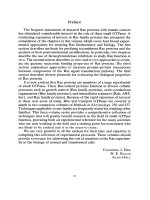Spanish Savings Banks and their Future Transformation into Private Capital Banks.Determining their Value by a Multicriteria Valuation Methodology doc
Bạn đang xem bản rút gọn của tài liệu. Xem và tải ngay bản đầy đủ của tài liệu tại đây (99.59 KB, 10 trang )
European Journal of Economics, Finance and Administrative Sciences
ISSN 1450-2275 Issue 35 (2011)
© EuroJournals, Inc. 2011
Spanish Savings Banks and their Future Transformation into
Private Capital Banks.Determining their Value by a
Multicriteria Valuation Methodology
Aznar Bellver, Jerónimo
Faculty of Business Administration and Management, Economics and Social
Sciences Department, Universidad Politécnica de Valencia
Camino de Vera s/n, 46022, Valencia (Spain)
Tel: +34-963877007; ext.74743
E-mail:
Cervelló Royo, Roberto
Faculty of Business Administration and Management, Economics and Social
Sciences Department, Universidad Politécnica de Valencia
Camino de Vera s/n, 46022, Valencia (Spain)
Tel: +34-963877007; ext.74710
E-mail:
García García, Fernando
Faculty of Business Administration and Management, Economics and Social
Sciences Department, Universidad Politécnica de Valencia
Camino de Vera s/n, 46022, Valencia (Spain)
Tel: +34-963877007; ext.74761
E-mail:
Abstract
As the result of the current international financial crisis and due to Basel II and Basel III
Capital Accords, the Spanish financial system is undergoing profound changes. Among the
most significant changes are the mergers of savings banks and their future transformation
into private capital banks. Therefore, determining the value of these financial companies
and their share prices is of great interest for different economic agents. This paper presents
the application of a multicriteria method called CRITIC, combined with the valuation ratio,
which together compose a valuation model. This new approach can overcome some of the
problems faced by the traditional valuation methods since it calculates the value of a
company by comparing with similar companies whose value is known. The comparison is
made using criteria or variables which are indicative of the value of these types of
companies. A case study is presented in which the combined methodology is applied to the
valuation of a particular Spanish savings bank.
Keywords: Savings Banks, Business Valuation, Valuation Ratio, Multiple Criteria
Analysis, CRITIC.
156 European Journal of Economics, Finance And Administrative Sciences - Issue 35 (2011)
1. Introduction
Business valuation is of great importance in the current economic climate. In fact, knowing the
monetary value of an enterprise is necessary on many occasions, such as, inter alia, in the case of
capital increases, mergers, spin-offs, acquisitions, public offering of securities, and investment finance.
Business valuations are also common in the event of donations and legacies. In our case of study, we
will focus on the mergers of Spanish savings banks. The future transformation into private capital
banks of these financial institutions which currently have a special legal status, have no shareholders
and which are not listed on the stock market, cannot be ruled out (Sinn, 2003). Therefore, determining
the value of these financial companies and their share prices is of great interest for different economic
agents.
There are different methodological approaches to valuation. Under the International Valuation
Standards (2007) valuation methods are divided into three major groups: market comparison methods
or market value approach, net present value approach and cost approach. However, these traditional
valuation methods, despite their obvious utility, have a number of limitations:
1) Certain of the comparative methods such as regression analysis, require a comprehensive
database of comparable assets. In numerous cases the available database is not large
enough, as is a common problem in the case of business valuation.
2) In the net present value approach, previously estimated data is used since this method is
based on predicting the future evolution of the asset to be valued. In the case of business
valuation, this involves calculating future cash flows and their residual value and applying
an appropriate discount rate. Clearly, these forecasts lead to a high degree of subjectivity in
the valuations, which are very sensitive to changes in the future scenarios considered.
3) The cost methods are valuation methods applied only to buildings and urban land.
4) In all these traditional valuation methods, it is difficult to directly introduce qualitative
variables in the valuation process. This is a serious limitation, since the importance on the
value of the company of aspects such as business leadership, professionalism of the human
team, reputation and international standing, etc. is undeniable.
All these limitations have led researchers in the field of valuation to search for alternative
methods enabling these deficiencies to be remedied. Certain of these methods are within the field of
multicriteria decision-making, including valuation applications such as goal programming (Aznar &
Guijarro, 2007 a and 2007 b), the analytical network process (Aragonés, Aznar, Ferris & García-
Melón, 2008, Garcia-Melón, Ferrís-Oñate, Aznar-Bellver, Aragonés-Beltrán & Poveda-Bautista, 2008)
and a combination of several of these techniques (Aznar, Guijarro & Moreno-Jiménez, 2008).
This paper proposes a new valuation model composed by CRITIC and the valuation ratio. This
model is classified as a comparative method, since it calculates the value of an asset by comparing it
with similar assets whose value is known and the comparison is made using criteria or variables which
are indicative of the value of these types of assets. In the case of the business valuation, the unknown
value of a company is calculated by comparing it with other companies whose value is known, e.g. due
to their listing on the stock market. For this purpose a number of criteria are used which are indicative
of the value of this type of companies.
The remainder of this paper is structured as follows. Section two presents the new valuation
method. Section three presents a case study in which the new method is applied and finally, section
four provides conclusions.
2. Valuation Model
The valuation model proposed is composed of the CRITIC (Diakauloki, Mavrotas & Papayannakis,
1995) and valuation ratio (International Valuation Standards, 2007) methods, and consists of the
following steps:
First Step. Selection of comparable companies
Second Step. Selection of criteria indicative of value
157 European Journal of Economics, Finance And Administrative Sciences - Issue 35 (2011)
Third Step. Weighting of the criteria using CRITIC
Fourth Step. Weighting of the companies
Fifth Step. Calculation of the valuation ratio
Sixth Step. Calculation of the value of the target company
Seventh Step. Validation of the model
The method proponed is particularly suitable for valuations of companies in which the number
of comparable companies is small and the data used is taken from the company’s accounting records. It
also allows for the inclusion of qualitative variables by means of their combination with AHP, although
this issue is not addressed in the case study presented in section 3.
Following is a more detailed description of each of the steps in the valuation process.
First Step. Selection of Comparable Companies
Once the company to be valued is selected, the first step is to identify the comparable companies,
which must be similar, and therefore, comparable to the company to be valued. Additionally, the value
of these companies must be known, for example, because they are listed on the stock market.
Second Step. Selection of Criteria Indicative of Value
In this step the criteria to be used in the comparison process are chosen and the database is created. As
previously mentioned, the proposed valuation method is based on the comparison of companies. Based
on this comparison and once the economic value of the comparable companies is known, the value of
the target company is calculated. Therefore, it is essential to determine the variables according to
which this comparison will be made. In the literature on business valuation, economic and financial
variables taken from accounting records are primarily used. The use of such variables is widespread,
not only in the field of business valuation, but also in fields as diverse as credit risk analysis (Beaver
(1966,1968), Altman (1961, 1968, 1973, 1993), Ohlson (1980), Sun & Shenoy (2007), Wang and Lee
(2008), Psillaki, Tsolas & Margaritis (2010), Li, Adeli, Sun & Han (2011)), analysis of business
performance (Yeh (1996), Halkos & Salamouris (2004), Malhotra (2009)) or the development of
company rankings (Feng & Wang (2001) Deng, Yeh & Willis. (2000). In these studies a wide range of
input methodology is used such as discriminant analysis, factor analysis, the logit and probit models
and the artificial neuronal networks, DEA or TOPSIS.
Third Step. Weighting of Criteria Using CRITIC
The weight or importance of the different criteria is measured by means of CRITIC. It would be
unreasonable to consider all the variables or criteria selected to have the same importance or influence
on the business value. Therefore, it is necessary to objectively allocate a weight to each of the criteria
chosen in the previous step.
CRITIC (Criteria Importance Through Intercriteria Correlation) (Diakoulaki et al., 1995) is a
criteria weighting method which defines their importance based on standard values for the range (1).
)1(*w
1
jj
∑∑
−=
=
jk
n
j
rS
(1)
being
j
w
= weight of criterion
j
j
s
= standard deviation of criterion
j
jk
r
= Correlation coefficient between criteria
j
and
k
.
The weights obtained (
wj
) are normalized by the sum.
Applying CRITIC, the higher its standard deviation and the lower its correlation with other
criteria, the higher the weight of the criteria. Accordingly, the weights of the criteria are determined
158 European Journal of Economics, Finance And Administrative Sciences - Issue 35 (2011)
based on two fundamental notions of MCDM: the contrast intensity and the conflicting character of the
evaluation criteria.
Fourth Step. Weighting of the Companies
After having obtained the weight
j
w
of each of the criteria, the weighting of the different companies is
calculated as follows (2):
ij
n
j
c×=
∑
=1
ji
wx
(2)
where
i
x
is the weighting of the company
i
,
j
w
is the weight of the criteria
j
,
ij
c
is the value of the criteria
j
for the company
i
Fifth Step. Calculation of the Valuation Ratio
The valuation ratio is a methodology proposed in the International Valuation Standards (2007) and is
defined as “A factor wherein a value or price serves as the numerator and financial, operating, or
physical data serve as the denominator”, its mathematical expression being (3). In our case, the
numerator is the sum of the value of comparable companies or another related type of parameter and
the denominator is the sum of the weights of comparable companies obtained in the previous step
(fourth step).
∑
∑
=
=
=
n
i
i
n
i
i
x
V
VR
1
1
(3)
being
VR
= Valuation Ratio
i
V
= Value of company
i
i
x
= Company’s weight obtained with CRITIC
This ratio indicates the value of the companies per unit of weight.
Sixth Step. Calculation of the Value of the Target Company
The value of the target company is calculated by multiplying the ratio obtained in (3) by the weight of
the company to be valued obtained when applying (1).
The proposed valuation procedure can be defined as a business valuation method within the
group of comparative or market approach methods, the result being “the estimated amount for which a
property should exchange on the date of valuation between a willing buyer and a willing seller in an
arm`s-length transaction after proper marketing wherein the parties had each acted knowledgeably,
prudently, and without compulsion”(IVS 2007).
Seventh Step. Validation of the Model
The value of the comparable companies is obtained using the valuation ratio, in order to verify that the
values obtained in this way are within the range of the company’s actual value.
159 European Journal of Economics, Finance And Administrative Sciences - Issue 35 (2011)
3. Empiric Design: Case Study and Results
In this section the proposed method is applied to the valuation of a Spanish savings bank whose
features are comparable to those of certain financial institutions already listed on the Spanish stock
market. The choice of a Spanish savings bank as the company to be valued was not arbitrary. As the
result of the current international financial crisis and due to Basel II and Basel III Capital Accords
(Basel Committee on Banking Supervision, 2004, 2010), the Spanish financial system is undergoing
profound changes. Among the most significant changes are the mergers of savings banks. The future
transformation into private capital banks of these financial institutions which currently have a special
legal status, have no shareholders and which are not listed on the stock market, cannot be ruled out
(Sinn, 2003). In fact, there are many international organizations such as the IMF which advocate a
change in Spanish law in this direction. In the case of a change in this sector towards privatization, e.g.
through public offerings of securities, we believe that the method presented in this paper would be of
great aid to assessors responsible for determining the value of financial institutions, and therefore, the
starting price of the shares.
First Step. Selection of Comparable Companies
For the purpose of the valuation, the comparable banks chosen are listed Spanish banks whose size and
turnover are similar to the savings bank to be valued (Banco Pastor, Bankinter, Banco Sabadell,
Banesto and Banco Popular). Since there are few comparable banks available, this case is ideal for the
implementation of the new valuation procedure.
The savings bank valued is “Caja de Ahorros del Mediterráneo” (CAM), which was founded in
1875 and was the first savings bank to issue non-voting shares. Given features such as its asset value
(71,441,621 thousand euros) and profit (276,547 thousand euros), this bank is comparable to several
listed financial institutions, as shown in table 1.
Table 1: Economic and financial data at 31/12/2009
Pastor Bankinter Sabadell Banesto Popular
Total Assets (thousands €) 32,325,235 54,467,584 82,822,886 126,220,639 129,290,148
Net Profit (thousands €) 102,591 254,404 526,309 558,824 780,347
Following is a breakdown of the steps in the valuation process described in the previous
section.
Second Step. Selection of Criteria Indicative of Value
As previously discussed, the choice of economic and financial variables which will be used as the
criteria for the purposes of the comparison of the companies is a key step. However, in literature there
is no defined list of accounting ratios which should be used. In our case, the choice of accounting ratios
is based on previous work analysing the performance of financial institutions using financial ratios
such as Kumbhakar (2001), Pastor (2002), Prior (2003), Iannotta, Nocera & Sironi (2007) and García,
Guijarro & Moy0061 (2010 b).
As a result of this bibliographical review, it was determined that all the ratios used can be
grouped into different categories. In other words: There are certain dimensions of the economic and
financial structure that are essential when characterizing a financial institution. The following
dimensions continuously appear: inputs, outputs and risk management. The representative “inputs”
chosen were labour cost, the cost of physical capital and the cost of deposits/capital. The representative
“outputs” chosen were ROA (Return On Assets) and the return on borrowed capital. Finally, the
default rate, coverage fund and BIS ratio are the criteria that represent the entity's risk management. It
should be taken into account that in accordance with the principle “the more the better”, the inverse of
both the criteria included in the group of inputs and the default rate is calculated.
160 European Journal of Economics, Finance And Administrative Sciences - Issue 35 (2011)
Table 2 shows the financial ratios serving as criteria in the valuation process, how the ratios are
calculated based on accounting information and which business dimension they represent.
Table 2: Ratios used to value the company by dimension and information source
Dimension Ratio Formula
Inputs Labour Cost
Cost of Physical Capital
Staff Costs
Depreciation/Property, Plant and Equipment
Deposit Costs/Capital Interest and Similar Charges/Financial
Liabilities at Amortised Cost
ROA Profit for the Year/Total Assets
Output Return on Borrowed Capital Interest and Similar Charges/Credit
Investments
Risk Management Default rate
Coverage Fund
BIS Ratio
The values of the company's financial ratios used in the valuation are shown in table 3.
Table 3: Values of financial ratios for 2009
CAM Pastor Bankinter Sabadell Banesto Popular Average
Standar
d
Deviatio
n
INPUTS
Labour 60.346 62.950 72.087 75.568 73.185 54.886 66.503 8.288
Cost of physical
capital 0.040 0.154 0.372 0.059 0.082 0.058 0.128 0.126
Deposit Costs/Capital 0.029 0.021 0.003 0.021 0.018 0.019 0.018 0.009
OUTPUTS
ROA 0.004 0.003 0.005 0.006 0.004 0.006 0.005 0.001
Return on borrowed
capital 0.058 0.051 0.008 0.048 0.038 0.049 0.042 0.018
RATES
Default rate 0.045 0.049 0.026 0.037 0.029 0.048 0.039 0.010
Coverage fund 0.707 1.187 0.744 0.690 0.634 0.503 0.744 0.233
BIS ratio 0.120 0.125 0.114 0.108 0.113 0.096 0.113 0.010
Third Step. Weighting of Criteria by Means of CRITIC
With CRITIC, the weights for each of the criteria are determined. First, the variables are normalized by
the range and the standard deviation for each parameter, as well as the correlation matrix, are then
calculated. Second, the weights (
j
w
) calculated by (1) are normalised by the sum, for the purpose of
obtaining the weight (
j
w
standardized) of the variables. See table 4.
Table 4: Correlation matrix, standard deviation and weightings
(1) (2) (3) (4) (5) (6) (7) (8)
j
w
j
w
Standardized
(1) Labour 1.000 0.401 -0.349 -0.078 0.482 -0.738 -0.087 -0.242 3.011 0.128
(2)Cost of physical capital 0.401 1.000 -0.692 0.271 0.743 -0.557 -0.475 -0.191 2.721 0.116
(3)Deposit Costs/Capital -0.349 -0.692 1.000 -0.036 -0.941 0.764 -0.012 -0.018 3.238 0.137
(4)ROA -0.078 0.271 -0.036 1.000 0.001 0.055 -0.709 -0.817 3.220 0.137
(5)Return on borrowed
capital 0.482 0.743 -0.941 0.001 1.000 -0.862 0.086 0.121 2.649 0.112
(6)Default rate -0.738 -0.557 0.764 0.055 -0.862 1.000 -0.219 0.007 3.556 0.151
161 European Journal of Economics, Finance And Administrative Sciences - Issue 35 (2011)
Table 4: Correlation matrix, standard deviation and weightings - continued
(7)Coverage fund -0.087 -0.475 -0.012 -0.709 0.086 -0.219 1.000 0.775 2.599 0.110
(8) BIS ratio -0.242 -0.191 -0.018 -0.817 0.121 0.007 0.775 1.000 2.566 0.109
Standard deviation 0.396 0.363 0.391 0.387 0.360 0.416 0.340 0.348
Fourth Step. Weighting of the Companies
Once the weights for each criterion is calculated by (2), the weights of the different financial
institutions are obtained.
Table 5: Weights of each financial institution
Weight
CAM 0.482
Pastor 0.411
Bankinter 0.476
Sabadell 0.435
Banesto 0.387
Popular 0.432
Fifth Step. Calculation of the Valuation Ratio
Despite the fact that the banks chosen as comparable companies are the most similar of those listed on
the stock market, the stock market value range is very high. In order to standardise the information
relating to the numerator of the valuation ratio, rather than this value, a relative magnitude, the price-
to-book ratio, i.e. the ratio between the average stock market price and book value in 2009 was chosen.
As the denominator of the valuation ratio, according to (3), the weights of the financial
institutions obtained in step four are used.
Table 6: Price-to-Book Ratio and CRITIC Ratio
Mean Stock Market
Value 2009 (€)
Equit (Book Value) (€) P to B Ratio Weight
CAM 2,837,237,000 - 0.482
Pastor 1,308,968,563.016 1,610,211,000 0.813 0.411
Bankinter 3,737,675,124.926 2,583,011,000 1.447 0.476
Sabadell 5,264,075,433.071 5,297,370,000 0.994 0.435
Banesto 5,407,951,190.048 5,472,536,000 0.988 0.387
Popular 7,837,245,800.617 8,447,984,000 0.928 0.432
As a result of applying (3)
414.2
432
.
0
387
.
0
435
.
0
476
.
0
411
.
0
928.0988.0994.0447.1813.0
=
++++
+
+
+
+
=VR
the valuation ratio VR= 2.414
Sixth Step. Calculation of the Stock Market Value of CAM
Based on the valuation ratio and the price-to-book ratio of CAM, the market value per unit of equity is
obtained.
Market value per unit of equity of the CAM = 2.414*0.482=1.163 €
By multiplying the market value per unit of equity of CAM and its equity, the stock market
value of CAM is obtained.
Stock market value of CAM= 1.163*2,837,237,000=3,301,261,436.876 €
162 European Journal of Economics, Finance And Administrative Sciences - Issue 35 (2011)
Seventh Step. Validation of the Model
To validate the model, the prices of the shares of each of the financial institutions used as comparable
banks are calculated by means of the valuation ratio obtained. In this way it is possible to determine
whether the calculated values of the comparable banks are within the stock mark price range of these
shares in the period from September 2009 up to the valuation date in September 2010.
As can be observed in table 7, in all cases the calculated price is within the stock market price
range.
Table 7: Price per share: Theoretical market price vs. real market price in the period from September 2009-
September 2010
Calculated Value (€) Min (€) Max (€)
Pastor 4.980 3.100 6.024
Bankinter 4.504 4.195 9.160
Sabadell 3.668 2.970 5.111
Banesto 5.764 4.930 9.534
Popular 5.298 3.320 7.441
4. Summary and Concluding Remarks
This paper presents the application of a multicriteria method called the CRITIC method, combined
with the valuation ratio, which together compose a valuation model which we have called
CRITICRatio. This method is classified as a comparative valuation or market approach method. It is
applied to the valuation of companies in environments with scarce information in terms of the number
of comparable entities, as long as economic and financial information is available. The main strength
of the proposed method is essentially that it can be used even when the number of comparable
companies is very limited, which is a common problem in the field of business valuation that prevents
other methods from being used. This method can be used, inter alia, for the valuation of companies
which are not listed, but whose business activity and size are similar to others which are listed and
whose market capitalizations represent a proxy for the companies’ market value.
The method is divided into seven steps beginning with the selection of the comparable
companies, followed by the weighting of variables and companies using CRITIC and finally the
calculation of value using the Valuation Ratio.
After presenting the new method, a valuation case study was proposed. The company chosen to
be valued was a Spanish savings bank called “Caja de Ahorros del Mediterráneo” (CAM). This was an
ideal company on which to use the new method since it is a financial institution comparable to several
banks listed on the Spanish stock market. As the number of comparable banks was limited, other
comparative valuation methods could not be applied properly. Additionally, this example was very
practical, give the current situation of savings banks in the Spanish financial system.
It is important to highlight that this proposal is not meant to replace the already existing
valuation methods. It is simply meant to provide valuers with an additional tool which enables them to
value problematic companies more exactly and for use in valuations in which the use of traditional
methods is impossible or inappropriate.
Finally, this paper does not exhaust this line of research related to multicriteria business
valuation, rather the opposite. In fact, in the future, the aim is to develop this model further to include
qualitative variables using AHP.
References
1] Altman, E.I. 1993. “Corporate financial distress and bankruptcy: A complete guide to
predicting and avoiding distress and profiting from bankruptcy”. Wiley, New York.
163 European Journal of Economics, Finance And Administrative Sciences - Issue 35 (2011)
2] Altman, E.I. 1973. “Predicting railroad bankruptcies in America”, Bell Journal of Economics
and Management Science 4(1), pp.184-211.
3] Altman, E.I. 1968. “Financial ratios, discriminant analysis and the prediction of corporate
bankrupcy”, The Journal of Finance, 23(4), pp. 589-609.
4] Altman, E.I. 1961. “Corporate bankruptcy in America”. DC Heath & Company, Lexington-
Mass.
5] Aragonés, P., Aznar, J., Ferris, J., García-Melón, M. 2008. “Valuation of urban industrial land:
An analytic network process approach”, European Journal of Operational Research, 185(1),
pp. 322-339
6] Aznar, J., Guijarro, F. 2007ª. “Estimating regression parameters with imprecise input data in an
appraisal context”, European Journal of Operational Research, 176(3), pp.1896-1907
7] Aznar, J., Guijarro, F. 2007b. “Modeling aesthetic variables in the valuation of paintings: an
interval goal programming aproach”, Journal of the Operational Research Society, 58, pp. 957-
963
8] Aznar, J., Guijarro, F. , Moreno-Jiménez, J.M. 2008. “Mixed valuation methods: a combined
AHP-GP procedure for individual and group multicriteria agricultural valuation”, Annals of
Operations Research, (in press), DOI 10.1007/s10479-009-05272-2
9] Basel Committee on Banking Supervision (2004). International Convergence of Capital
Measurement and Capital Standards, A revised framework. Basel, Bank for International
Settlements, Basel Committee on Banking Supervision, June 2004.
10] Basel Committee on Banking Supervision (2010). Basel III: A global regulatory framework for
more resilient banks and banking systems. Basel, Bank for International Settlements, Basel
Committee on Banking Supervision, December 2010.
11] Beaver, W.H. 1996. “Financial ratios as predictors of failure”, Empirical Research in
Accounting: Selected studies, 4, pp.71-111.
12] Beaver, W.H. 1968. “Alternative accounting measures as predictors of failure”, Accounting
Review of Accounting Studies, 1, pp. 267-284.
13] Deng, H., Yeh, CH., Willis, R.J. 2000. “Inter-company comparison using modified TOPSIS
with objective weigts”, Computers & Operations Research, 27, pp.963-973.
14] Diakoulaki, D., Mavrotas, G., Papayannakis, L. (1995). “Determining objective weights in
multiple criteria problems: The critic method”, Computers & Operations Research, 27, pp. 963-
973
15] Feng, CH. M., Wang, R.T. (2001). “Considering the financial ratios on the performance
evaluation of highway bus industry”, Transport Reviews, 21(4), pp.449-467.
16] Garcia, F., Guijarro, F., Moya, I. 2010a. “A goal programming approach to estimating
performance weights for ranking firms”, Computers and Operations Research, 37, pp. 1597-
1609.
17] Garcia, F., Guijarro, F., Moya, I. 2010b. “Ranking Spanish savings banks: A multicriteria
approach”, Mathematical and Computer Modelling, 52, pp.1058-1065.
18] Garcia-Melón, M., Ferrís-Oñate, J., Aznar-Bellver, J., Aragonés-Beltrán, P., Poveda-Bautista,
R. 2008. “Farmland appraisal based on the Analytic network process”, Journal of Global
Operational, 42, pp.143-155.
19] Halkos, G.E., Salamouris, D.S. 2004. “Efficiency measurement of the Greek commercial banks
with the use of financial ratios: a data envelopment analysis approach”, Management
Accounting Research, 15, pp.201-224.
20] Iannotta, G., Nocera, A., Sironi, A. 2007. “Ownweship structure, risk and performance in the
European banking industry”, Journal of Banking Finances, 31, pp.2127-2149.
21] International Valuation Standards Committee. 2007. International Valuation Standards, IVS.
22] Kumbhakar, S.C., Lozano-Vivas, A., Lovell, C.A.K., Hasan, I. 2001. “The effects of
deregulation on the performance of financial institutions: The case of Spanish savings banks”,
Journal of Money Credit Banking, 33, pp.101-120.
164 European Journal of Economics, Finance And Administrative Sciences - Issue 35 (2011)
23] Li, H., Adeli, H., Sun, J., Han, J.G. 2010. “Hibrydizing principles of TOPSIS with case based
reasoning for business failure prediction” , Computers and Operations Research, 38(2), pp.409-
419.
24] Malhotra, R., Malhotra, D.K., Lafond, A. 2009. “Analysing financial services industry using
data envelopment analysis”, International Journal of Applied Management Science, 1(3), pp.
217-246.
25] Ohlson, J.A. 1980. “Financial ratios and the probabilistic prediction of bankruptcy”, Journal of
Accounting Research, 18(1), pp. 109-131.
26] Pastor, J.M. 2002. “Credit risk and efficiency in the European banking system: A three stage
analysis”, Applied Financial Economics, 12, pp.895-911.
27] Pisillaki, M., Tsolas, I.E., Margaritis, D. 2010. “Evaluation of credit risk based on firm
performance”, European Journal of Operation Research, 201, pp.873-881.
28] Prior, D. 2003. “Long and short-run nonparametric cost frontier efficiency: An application to
Spanish saving banks”, Journal of Banking and Finances, 27, pp.107-123.
29] Sinn, H.W. 2003. “Risktaking, limited liability, and the competition of bank regulators”,
FinanzArchiv: Public Finance Analysis, 59 (3), pp.305-321.
30] Sun, L., Shenoy, P.P. 2007. “Using Bayesian networks for bankruptcy prediction: some
methodological issues”, European Journal of Operational Research, 180(2), pp.738-753.
31] Wang, Y.L., Lee, H.S. 2008. “A clustering method to identify representative financial ratios”,
Information Sciences, 178, pp.1087-1097.
32] Yeh, Q.J. 1996. “The application of data envelopment analysis in conjunction with financial
ratios for bank performance evaluation”, Journal of the Operational Research Society, 47,pp.
980-988.
